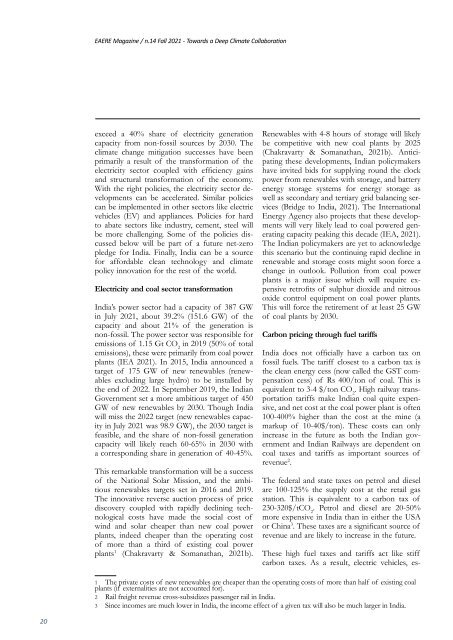EAERE Magazine - N.14 Fall 2021
You also want an ePaper? Increase the reach of your titles
YUMPU automatically turns print PDFs into web optimized ePapers that Google loves.
<strong>EAERE</strong> <strong>Magazine</strong> / n.14 <strong>Fall</strong> <strong>2021</strong> - Towards a Deep Climate Collaboration<br />
exceed a 40% share of electricity generation<br />
capacity from non-fossil sources by 2030. The<br />
climate change mitigation successes have been<br />
primarily a result of the transformation of the<br />
electricity sector coupled with efficiency gains<br />
and structural transformation of the economy.<br />
With the right policies, the electricity sector developments<br />
can be accelerated. Similar policies<br />
can be implemented in other sectors like electric<br />
vehicles (EV) and appliances. Policies for hard<br />
to abate sectors like industry, cement, steel will<br />
be more challenging. Some of the policies discussed<br />
below will be part of a future net-zero<br />
pledge for India. Finally, India can be a source<br />
for affordable clean technology and climate<br />
policy innovation for the rest of the world.<br />
Electricity and coal sector transformation<br />
India’s power sector had a capacity of 387 GW<br />
in July <strong>2021</strong>, about 39.2% (151.6 GW) of the<br />
capacity and about 21% of the generation is<br />
non-fossil. The power sector was responsible for<br />
emissions of 1.15 Gt CO 2<br />
in 2019 (50% of total<br />
emissions), these were primarily from coal power<br />
plants (IEA <strong>2021</strong>). In 2015, India announced a<br />
target of 175 GW of new renewables (renewables<br />
excluding large hydro) to be installed by<br />
the end of 2022. In September 2019, the Indian<br />
Government set a more ambitious target of 450<br />
GW of new renewables by 2030. Though India<br />
will miss the 2022 target (new renewables capacity<br />
in July <strong>2021</strong> was 98.9 GW), the 2030 target is<br />
feasible, and the share of non-fossil generation<br />
capacity will likely reach 60-65% in 2030 with<br />
a corresponding share in generation of 40-45%.<br />
This remarkable transformation will be a success<br />
of the National Solar Mission, and the ambitious<br />
renewables targets set in 2016 and 2019.<br />
The innovative reverse auction process of price<br />
discovery coupled with rapidly declining technological<br />
costs have made the social cost of<br />
wind and solar cheaper than new coal power<br />
plants, indeed cheaper than the operating cost<br />
of more than a third of existing coal power<br />
plants 1 (Chakravarty & Somanathan, <strong>2021</strong>b).<br />
Renewables with 4-8 hours of storage will likely<br />
be competitive with new coal plants by 2025<br />
(Chakravarty & Somanathan, <strong>2021</strong>b). Anticipating<br />
these developments, Indian policymakers<br />
have invited bids for supplying round the clock<br />
power from renewables with storage, and battery<br />
energy storage systems for energy storage as<br />
well as secondary and tertiary grid balancing services<br />
(Bridge to India, <strong>2021</strong>). The International<br />
Energy Agency also projects that these developments<br />
will very likely lead to coal powered generating<br />
capacity peaking this decade (IEA, <strong>2021</strong>).<br />
The Indian policymakers are yet to acknowledge<br />
this scenario but the continuing rapid decline in<br />
renewable and storage costs might soon force a<br />
change in outlook. Pollution from coal power<br />
plants is a major issue which will require expensive<br />
retrofits of sulphur dioxide and nitrous<br />
oxide control equipment on coal power plants.<br />
This will force the retirement of at least 25 GW<br />
of coal plants by 2030.<br />
Carbon pricing through fuel tariffs<br />
India does not officially have a carbon tax on<br />
fossil fuels. The tariff closest to a carbon tax is<br />
the clean energy cess (now called the GST compensation<br />
cess) of Rs 400/ton of coal. This is<br />
equivalent to 3-4 $/ton CO 2<br />
. High railway transportation<br />
tariffs make Indian coal quite expensive,<br />
and net cost at the coal power plant is often<br />
100-400% higher than the cost at the mine (a<br />
markup of 10-40$/ton). These costs can only<br />
increase in the future as both the Indian government<br />
and Indian Railways are dependent on<br />
coal taxes and tariffs as important sources of<br />
revenue 2 .<br />
The federal and state taxes on petrol and diesel<br />
are 100-125% the supply cost at the retail gas<br />
station. This is equivalent to a carbon tax of<br />
230-320$/tCO 2<br />
. Petrol and diesel are 20-50%<br />
more expensive in India than in either the USA<br />
or China 3 . These taxes are a significant source of<br />
revenue and are likely to increase in the future.<br />
These high fuel taxes and tariffs act like stiff<br />
carbon taxes. As a result, electric vehicles, es-<br />
1 The private costs of new renewables are cheaper than the operating costs of more than half of existing coal<br />
plants (if externalities are not accounted for).<br />
2 Rail freight revenue cross-subsidizes passenger rail in India.<br />
3 Since incomes are much lower in India, the income effect of a given tax will also be much larger in India.<br />
20













